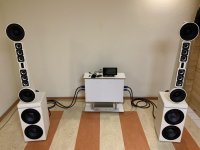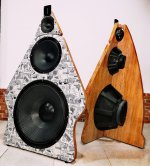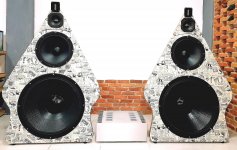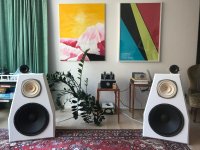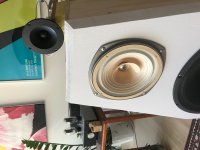The dipole 18 has dual-coils. Optimally one coil should be part of your analog system (perhaps even w/ a minimalist high-pass ie. series cap), and the other "active" DSP-eq.ed. at a lower freq. to correct for loss - ideally with a very high "current" amplifier (to lower non-linear distortion and get some benefit from that rising Impedance at resonance).
Mattes, what xo type did you use with dsp? I prefer LR2 acoustic over steeper ones. 48 or 96/Oct may look good on-axis, but drivers don't integrate sonically, off-axis suffers too.
Hi Juhazi,
with this design, I first tried to approximate the well-running passive filter, which is even a bit flatter than LR2, more something like B2, with an ADI-2 pro DAC "misused" as active CO. As above, after 48 hrs. I switched back for passive... but don´t ask me why. Measurements where very close of each other (sadly lost in a HD crash), but somehow I preferred the passive approach, well knowing that this is against "common wisdom", and of course not intending to start a new active/passive debate...
But I´m completely with you with regard to steep filters; I always preferred to work with material which don´t need to be filtered very steep. In fact, I don´t remember having ever built something steeper than 2nd order... but of course, as in the CO pictures above, shallow filters do not necessarily mean low count of elements.
Regards to Finland
Mattes
with this design, I first tried to approximate the well-running passive filter, which is even a bit flatter than LR2, more something like B2, with an ADI-2 pro DAC "misused" as active CO. As above, after 48 hrs. I switched back for passive... but don´t ask me why. Measurements where very close of each other (sadly lost in a HD crash), but somehow I preferred the passive approach, well knowing that this is against "common wisdom", and of course not intending to start a new active/passive debate...
But I´m completely with you with regard to steep filters; I always preferred to work with material which don´t need to be filtered very steep. In fact, I don´t remember having ever built something steeper than 2nd order... but of course, as in the CO pictures above, shallow filters do not necessarily mean low count of elements.
Regards to Finland
Mattes
Hi Scott,
never thought of this concept, have you ever tried it? I have at least trouble imaginating a decent HP cap for this, please forgive me... but I also feel no urge to change the current application for the AE 18.
Looking forward to learn about practical results though!
All the best
Mattes
never thought of this concept, have you ever tried it? I have at least trouble imaginating a decent HP cap for this, please forgive me... but I also feel no urge to change the current application for the AE 18.
Looking forward to learn about practical results though!
All the best
Mattes
For the AE 18 I haven't (other DVC's yes), but I did recommend it to John/AE originally.. I even participated in a thread here a long time ago about an "optimal" dipole woofer.
The high-pass isn't necessary.. BUT it can help with power-use for the "full-range" amplifier, plus it can sometimes improve/shunt back EMF that might "load" the output of that amplifier. Just a big cap with a high-voltage bypass cap typically around 100 Hz, perhaps a Mundorf Evo Oil 220 uf with a Cornell Dubilier 940C 1 uf/2kv in parallel.
As to the current amplifier - I've never seen that done, it would be a monstrous amplifier though. (..as an example: First Watt F1 is a current amplifier - with an output impedance around 30 ohms if I remember correctly. It's not a particularly powerful amplifier though - which is something required here.)
See what even this modest amplifier does with Impedance near resonance:
http://www.firstwatt.com/pdf/art_cs_amps.pdf
The more normal approach is using a high-output large current reservoir/ps amplifier like the Behringer KM1700. It's really of little importance what the quality of the amplifier is (provided it's a decent design) because it's basically in-use at low freq.s. HOWEVER, in this case I do like an LCR to flatten Impedance at resonance.
btw:
it would be preamp > amp > high-pass VC 1
and
preamp > miniDSP > bass amp > VC 2
The high-pass isn't necessary.. BUT it can help with power-use for the "full-range" amplifier, plus it can sometimes improve/shunt back EMF that might "load" the output of that amplifier. Just a big cap with a high-voltage bypass cap typically around 100 Hz, perhaps a Mundorf Evo Oil 220 uf with a Cornell Dubilier 940C 1 uf/2kv in parallel.
As to the current amplifier - I've never seen that done, it would be a monstrous amplifier though. (..as an example: First Watt F1 is a current amplifier - with an output impedance around 30 ohms if I remember correctly. It's not a particularly powerful amplifier though - which is something required here.)
See what even this modest amplifier does with Impedance near resonance:
http://www.firstwatt.com/pdf/art_cs_amps.pdf
The more normal approach is using a high-output large current reservoir/ps amplifier like the Behringer KM1700. It's really of little importance what the quality of the amplifier is (provided it's a decent design) because it's basically in-use at low freq.s. HOWEVER, in this case I do like an LCR to flatten Impedance at resonance.
btw:
it would be preamp > amp > high-pass VC 1
and
preamp > miniDSP > bass amp > VC 2
Matty said:As you state, that it is a form-follows-function design with no gimmicks, I would really be interested in how exactly the very special shape of the baffles works. I think, I have a rough idea, but it would be great, if you could give as more insights in how you developed it to exactly what it is, which sources (of knowledge) you used and of cause, measurements would be great
Hi Matthias,
your questions will easily open up a longer discussion (not that I´m afraid of it...), and I think it´s better to split off same from here.
Anybody else interested?
hey guys - I need your votes 😀😉
Last edited:
Line array meets open baffle
Hallo,
Let me introduce Safineia evo, 4 way Open baffle project, with Rpi Streamer (allodigione signature / RPi3b+); Hypex Fusion amp FA253/252, open baffle speaker with damped u-frame sub, line array mids and ribbon tweeter.
Best regards
Michael
Hallo,
Let me introduce Safineia evo, 4 way Open baffle project, with Rpi Streamer (allodigione signature / RPi3b+); Hypex Fusion amp FA253/252, open baffle speaker with damped u-frame sub, line array mids and ribbon tweeter.
Best regards
Michael
Attachments
Hallo,
Let me introduce Safineia evo, 4 way Open baffle project, with Rpi Streamer (allodigione signature / RPi3b+); Hypex Fusion amp FA253/252, open baffle speaker with damped u-frame sub, line array mids and ribbon tweeter.
Best regards
Michael
Hi Michael,
thanks for showing us.
Can you give us some more details?
I would be interested in
- which drivers are used
- xover frequencies and type
Thanks and regards
Matthias
Hallo Matthias,
The chassis which I used are based on best k*a / xo and lowest harmonic distorsion (based on Hobby-HiFi).
Sub: Visaton TIW 200 XS
Lower MID: SB Acoustics SB17NBAC
Upper MID (line array): SB Acoustics SB65
Tweeter: Aurum Cantus AST 2560
XO: 130Hz/1000Hz/4000Hz; LR4
Best regards
Michael
The chassis which I used are based on best k*a / xo and lowest harmonic distorsion (based on Hobby-HiFi).
Sub: Visaton TIW 200 XS
Lower MID: SB Acoustics SB17NBAC
Upper MID (line array): SB Acoustics SB65
Tweeter: Aurum Cantus AST 2560
XO: 130Hz/1000Hz/4000Hz; LR4
Best regards
Michael
Hi Michael,
nice to see some more crazy people in our country...
Very nice built and thoughtful design! Guess it was also a lot of work! Do I see some plexiglass baffles there, or is the line array completely naked?
Best regards
Mattes
nice to see some more crazy people in our country...
Very nice built and thoughtful design! Guess it was also a lot of work! Do I see some plexiglass baffles there, or is the line array completely naked?
Best regards
Mattes
Hi Matty,
you deserve a little bit more information with regards to the Dipole 18:
- First measurements showed the driver beeing 4-5 dB down in sensitivity from simulations which had been consistently precise until then (old AJhorn which is able to simulate OB). Well, one door closes, another opens, and by coincidence that was nearly the 16 kHz level of the FERTIN driver. A second magnet gave me back app. 1,5 dB to reach that level, so I eliminated the mountain in between and was happy.
- While rearranging the system to actual state, I took the chance to measure the drivers many times with various weights and positions. The reason for the mismatch with manufacturer´s data was a larger moving mass. With the self-measured TSP, simulations were correct again. Sadly, I can post the TSP only in November when I´m back home, as I´m at work right now.
- I added, as above, a second magnet ring on the back. Qts changed from 0,8 to 0,6, and I preferred the latter, and liked the subjectively better precision I was hearing.
- The Dipole 18 needs a lot of efforts to not shake whatever it´s build into. For the free-swinging installation, I added a 22 kg counterweight near the center of gravity to the rear of the motor, of course from amagnetic stainless steel. I would think of this as a minimum, the driver now weighs 42 kg, plus app. 3 kg for the (decoupled) baffle.
- I liked the sound very much from the beginning, despite the TSP flaws. The Dipole 18 can play low, loud and clean. It needs, however, a lot of power for that. I´m driving it with a Devialet 400, which shuts down somewhere at 600 or 700 Watts into 3,5 Ohms (double 8 Ohm VC). I can´t think about any alternatives if one wants passive 86 dBs/2,8 V down into the 20s with a reasonably sized OB.
All the best
Mattes
you deserve a little bit more information with regards to the Dipole 18:
- First measurements showed the driver beeing 4-5 dB down in sensitivity from simulations which had been consistently precise until then (old AJhorn which is able to simulate OB). Well, one door closes, another opens, and by coincidence that was nearly the 16 kHz level of the FERTIN driver. A second magnet gave me back app. 1,5 dB to reach that level, so I eliminated the mountain in between and was happy.
- While rearranging the system to actual state, I took the chance to measure the drivers many times with various weights and positions. The reason for the mismatch with manufacturer´s data was a larger moving mass. With the self-measured TSP, simulations were correct again. Sadly, I can post the TSP only in November when I´m back home, as I´m at work right now.
- I added, as above, a second magnet ring on the back. Qts changed from 0,8 to 0,6, and I preferred the latter, and liked the subjectively better precision I was hearing.
- The Dipole 18 needs a lot of efforts to not shake whatever it´s build into. For the free-swinging installation, I added a 22 kg counterweight near the center of gravity to the rear of the motor, of course from amagnetic stainless steel. I would think of this as a minimum, the driver now weighs 42 kg, plus app. 3 kg for the (decoupled) baffle.
- I liked the sound very much from the beginning, despite the TSP flaws. The Dipole 18 can play low, loud and clean. It needs, however, a lot of power for that. I´m driving it with a Devialet 400, which shuts down somewhere at 600 or 700 Watts into 3,5 Ohms (double 8 Ohm VC). I can´t think about any alternatives if one wants passive 86 dBs/2,8 V down into the 20s with a reasonably sized OB.
All the best
Mattes
"Gunungan" 4way dsp Open Baffle
DSP : Minidsp 2x4HD
Driver : Amplifier
21" ACR Fab 113212 : D4K5 1kW Class D
12" ACR Fab 75124 : D4K5 1kW Class D
5" PRV 5MR450 : PeeCeeBee v4 50W Class AB
Beston RT002-dipole : PeeCeeBee v4 50W Class AB
Next : crossover setup + measurement 👌 I will use Harsch xo as 1st try
DSP : Minidsp 2x4HD
Driver : Amplifier
21" ACR Fab 113212 : D4K5 1kW Class D
12" ACR Fab 75124 : D4K5 1kW Class D
5" PRV 5MR450 : PeeCeeBee v4 50W Class AB
Beston RT002-dipole : PeeCeeBee v4 50W Class AB
Next : crossover setup + measurement 👌 I will use Harsch xo as 1st try
Attachments
Hi Matthias,
your questions will easily open up a longer discussion (not that I´m afraid of it...), and I think it´s better to split off same from here.
Anybody else interested?....
I for one think your superb build deserves a dedicated thread, where your design rationale is revealed.
Hi Michael,
nice to see some more crazy people in our country...
Very nice built and thoughtful design! Guess it was also a lot of work! Do I see some plexiglass baffles there, or is the line array completely naked?
Best regards
Mattes
Hi Mattes,
Yes, there is only an open baffle for the line array, do to best dipol 8. You will find more pictures on octaaudio – DIY Open Baffle Projects.
Best regards
Michael
Hi Mattes,
Yes, there is only an open baffle for the line array, do to best dipol 8. You will find more pictures on octaaudio – DIY Open Baffle Projects.
Best regards
Michael
Nice job Michael. Excellent design.

"Gunungan" 4way dsp Open Baffle
DSP : Minidsp 2x4HD
Driver : Amplifier
21" ACR Fab 113212 : D4K5 1kW Class D
12" ACR Fab 75124 : D4K5 1kW Class D
5" PRV 5MR450 : PeeCeeBee v4 50W Class AB
Beston RT002-dipole : PeeCeeBee v4 50W Class AB
Next : crossover setup + measurement 👌 I will use Harsch xo as 1st try
Now this looks good! Which dsp are yo using? Anyway now the fun begins with listening, measuring and experimenting!
two of minidsp 2x4HD, making monoblock dsp + 4ch amplifierNow this looks good! Which dsp are yo using? Anyway now the fun begins with listening, measuring and experimenting!
indeed after electronic & woodworking completed, i'l have to learn on digital domain
Hi,
I'd like to show my 3 way active open baffles. They've been running well for a few years now, with occasional upgrades along the way.
They look like box speakers from the angle photos, because they are 'U' baffles - but they're open at the back.
Bass is 2x12", from BK electronics in the UK. Used in their well regarded 'Monolith' subs. Similar to Eminence Lab 12.
Mids are Dayton RS150 6" Ali cones. Vifa XT25 ring tweeters on Visaton WG148 waveguides, plus 19mm rear tweeters.
Amplification, 4 stereo amps = 8 channels. Heavily rebuilt Quad 405's with no current limiting.
Active crossover. Digital FIR linear phase, measured with REW, programmed in rePhase and run through Equalizer APO.
All music and processing on a windows computer. 20Hz-20KHz -3dB in room. Measured with Cross Spectrum individually calibrated UMIK-1.
Full size speakers on 'U' baffles are unusual because of the potential for resonances in the rear cavity. The up side is powerful extended bass which integrates perfectly with the rest of the speaker.
Actually the rear resonances are fairly easily tamed. A combination of design, damping and EQ tames them totally.
The speakers are curved and sloped, with no parallel sides or edges, so resonances are not encouraged at any particular frequency, and the rear cavity is well damped with foam and wool.
Any remaining resonances are smaller that the room resonances and can be EQ'd out easily.
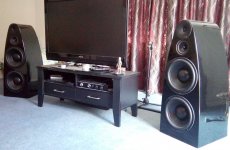
The finish on the speakers is Piano Black, so there are some weird reflections of furniture on the side of the right speaker.
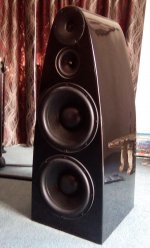
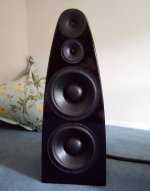
I'd like to show my 3 way active open baffles. They've been running well for a few years now, with occasional upgrades along the way.
They look like box speakers from the angle photos, because they are 'U' baffles - but they're open at the back.
Bass is 2x12", from BK electronics in the UK. Used in their well regarded 'Monolith' subs. Similar to Eminence Lab 12.
Mids are Dayton RS150 6" Ali cones. Vifa XT25 ring tweeters on Visaton WG148 waveguides, plus 19mm rear tweeters.
Amplification, 4 stereo amps = 8 channels. Heavily rebuilt Quad 405's with no current limiting.
Active crossover. Digital FIR linear phase, measured with REW, programmed in rePhase and run through Equalizer APO.
All music and processing on a windows computer. 20Hz-20KHz -3dB in room. Measured with Cross Spectrum individually calibrated UMIK-1.
Full size speakers on 'U' baffles are unusual because of the potential for resonances in the rear cavity. The up side is powerful extended bass which integrates perfectly with the rest of the speaker.
Actually the rear resonances are fairly easily tamed. A combination of design, damping and EQ tames them totally.
The speakers are curved and sloped, with no parallel sides or edges, so resonances are not encouraged at any particular frequency, and the rear cavity is well damped with foam and wool.
Any remaining resonances are smaller that the room resonances and can be EQ'd out easily.

The finish on the speakers is Piano Black, so there are some weird reflections of furniture on the side of the right speaker.


Hi,
I'd like to show my 3 way active open baffles. They've been running well for a few years now, with occasional upgrades along the way.
They look like box speakers from the angle photos, because they are 'U' baffles - but they're open at the back.
Bass is 2x12", from BK electronics in the UK. Used in their well regarded 'Monolith' subs. Similar to Eminence Lab 12.
Mids are Dayton RS150 6" Ali cones. Vifa XT25 ring tweeters on Visaton WG148 waveguides, plus 19mm rear tweeters.
Amplification, 4 stereo amps = 8 channels. Heavily rebuilt Quad 405's with no current limiting.
Active crossover. Digital FIR linear phase, measured with REW, programmed in rePhase and run through Equalizer APO.
All music and processing on a windows computer. 20Hz-20KHz -3dB in room. Measured with Cross Spectrum individually calibrated UMIK-1.
Full size speakers on 'U' baffles are unusual because of the potential for resonances in the rear cavity. The up side is powerful extended bass which integrates perfectly with the rest of the speaker.
Actually the rear resonances are fairly easily tamed. A combination of design, damping and EQ tames them totally.
The speakers are curved and sloped, with no parallel sides or edges, so resonances are not encouraged at any particular frequency, and the rear cavity is well damped with foam and wool.
Any remaining resonances are smaller that the room resonances and can be EQ'd out easily.
View attachment 789166
The finish on the speakers is Piano Black, so there are some weird reflections of furniture on the side of the right speaker.
View attachment 789163
View attachment 789164
Beauty.
Any snaps of the back of the speakers? Curious your methods. Wish I could hear em.
- Home
- Loudspeakers
- Multi-Way
- Ultimate Open Baffle Gallery
